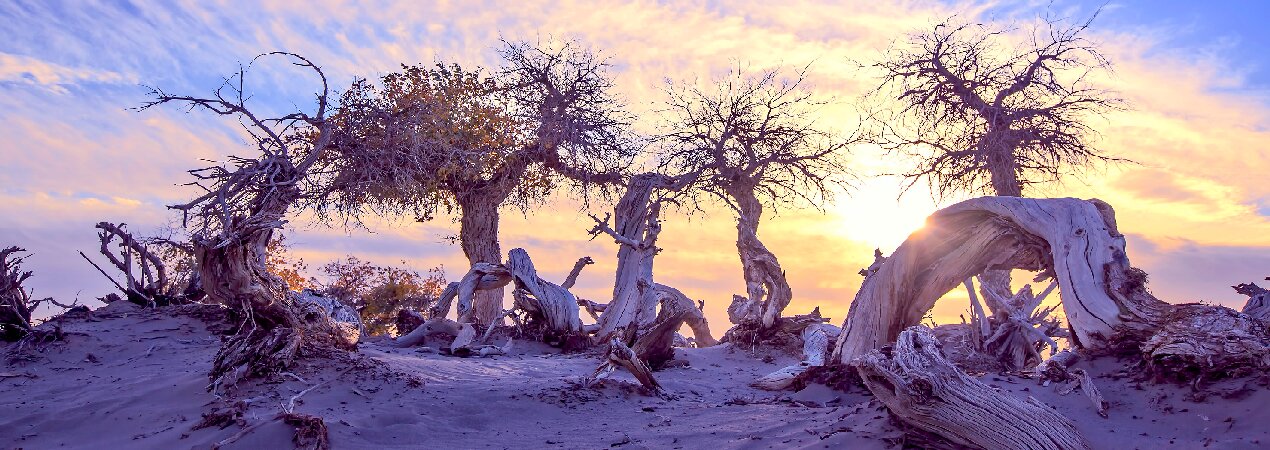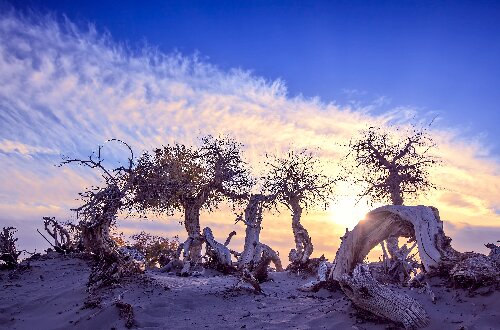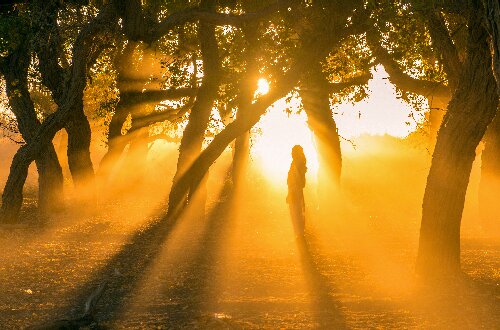Yiwu Populus Euphratica Forest

The Yiwu Populus euphratica forest is one of the three largest Populus euphratica forests in the world. It is a Populus euphratica forest with a relatively concentrated distribution in China. It is also one of the world's oldest original Populus euphratica forests with the most distinctive tree shapes and the best accessibility.
- Chinese name: 伊吾胡杨林 Yī Wú Hú Yáng Lín
- Suggested time: 4-5 hours
- Ticket: 35 yuan per person. If you choose to take a sightseeing vehicle for the tour, you need to purchase an additional ticket.
- Open hours: 9:00 - 19:00
- The best time to visit: From late September to early November
- Address: Populus euphratica Forest Scenic Area, Huyang Avenue, Naomaohu Town, Yiwu County, Hami City, Xinjiang Uygur Autonomous Region, China
- How to get there: It is recommended to take a taxi to the Yiwu Populus euphratica forest scenic area.
Highlights of Yiwu Populus Euphratica Forest
Ten-Thousand-Year Root Carving Area
 Populus Euphratica Trees in Diverse Forms
Populus Euphratica Trees in Diverse FormsStarting from the tourist center, you will first enter the Ten-Thousand-Year Root Carving Area, which is known as the museum of Populus euphratica root carving art. Composed of thousands of ancient Populus euphratica trees, it features smooth and graceful curves and diverse forms. Most of the Populus euphratica trees here have no leaf veins or branches, leaving only trunks or roots, yet they still stand firm in the desert. They exhibit countless postures, and some resemble phoenixes, cranes, or squirrels, vivid and fascinating.
One-Thousand-Year Area
In the One-Thousand-Year Area, Populus euphratica trees thrive densely with abundant vitality, presenting their young form. Here, the tree trunks are tough and straight, while the canopies are lush with greenery, resembling a neatly arranged formation.
Three-Thousand-Year Area
In the Three-Thousand-Year Area, Populus euphratica trees display diverse forms, allowing visitors to feel the magic of nature. This area was once the habitat of pterosaurs. By integrating pterosaur elements into the poplar forest, it makes visitors feel as if they have stepped into the Jurassic period, unable to resist exploring the mysterious world where poplars and dinosaurs coexist.
Six-Thousand-Year Area
Also known as the Populus Euphratica Secret Realm, this area offers visitors the chance to watch Twelve Muqam folk performances and serves as the perfect spot for rest and cooling off. The poplar trees here resemble a natural art palace, with diverse forms: some look like camels carrying loads, others curl up like dragons and snakes on the ground, some stand majestically like lions and tigers, while others seem to neigh like galloping horses. These groups of poplar "sculptures" are formed by the magic of nature.
Nine-Thousand-Year Area
 Sunlight Penetrating the Populus Euphratica Forest
Sunlight Penetrating the Populus Euphratica ForestThe Populus euphratica trees in the Nine-Thousand-Year Area have a long history and are beloved by visitors. With a broad view and fresh air, this area is the best spot to watch the sunrise. Here, you can see golden rays of dawn illuminating the earth, and thousands of poplar trees glowing golden in the sunlight, making it perfect for photography.
Recommended Tour Route: Tourist Service Center → Ten-Thousand-Year Root Carving Area → One-Thousand-Year Area → Three-Thousand-Year Area → Six-Thousand-Year Area → Nine-Thousand-Year Area
Educational Value
Populus euphratica has existed on Earth for about 65 million years. The tree ages in Yiwu Populus euphratica Forest range from thousands to nearly ten thousand years, and their growth patterns and tree ring structures can serve as evidence for studying geological changes.
Activities to do at Yiwu Populus Euphratica Forest
Photography: In spring, the tender green of new leaves contrasts with the desert; in autumn, golden leaves against the sunset create classic scenes like the "Golden Populus Euphratica Forest"; in winter, snow-covered poplars capture the tranquil beauty of the "White Populus Euphratica Forest".
Art Creation: With diverse shapes, Populus euphratica trees serve as references for sketching and artistic painting. Visitors can also make specimens or creative handicrafts using fallen leaves and branches.
Drop us a line and we'll connect you with the top China expert in no time!